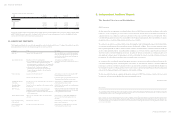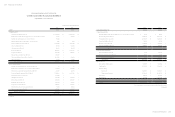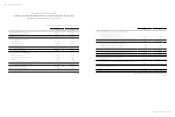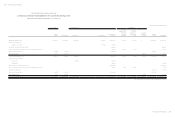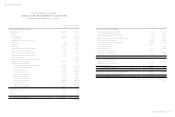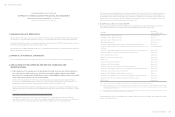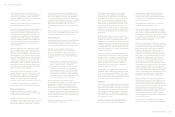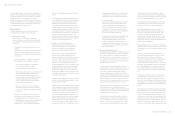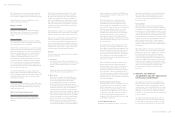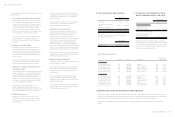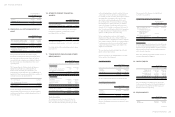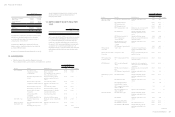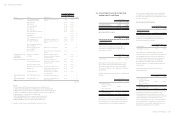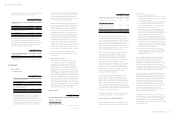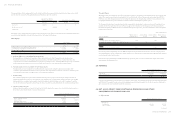HTC 2015 Annual Report Download - page 128
Download and view the complete annual report
Please find page 128 of the 2015 HTC annual report below. You can navigate through the pages in the report by either clicking on the pages listed below, or by using the keyword search tool below to find specific information within the annual report.
Financial information
Financial information
252
253
allowance account are recognized in profit or loss.
c. Derecognition of financial assets
The Company derecognizes a financial asset only when
the contractual rights to the cash flows from the asset
expire, or when it transfers the financial asset and
substantially all the risks and rewards of ownership of the
asset to another party.
On derecognition of a financial asset in its entirety, the
difference between the asset's carrying amount and the
sum of the consideration received and receivable and the
cumulative gain or loss that had been recognized in other
comprehensive income and accumulated in equity is
recognized in profit or loss.
Equity instruments
Debt and equity instruments issued by a group entity
are classified as either financial liabilities or as equity
in accordance with the substance of the contractual
arrangements and the definitions of a financial liability and an
equity instrument.
Equity instruments issued by a group entity are recognized at
the proceeds received, net of direct issue costs.
Repurchase of the Company's own equity instruments is
recognized in and deducted directly from equity. No gain or
loss is recognized in profit or loss on the purchase, sale, issue
or cancellation of the Company's own equity instruments.
Financial liabilities
a. Subsequent measurement
Except the following situation, all the financial liabilities
are measured at amortized cost using the effective interest
method:
Financial liabilities at fair value through profit or loss
(FVTPL)
Financial liabilities are classified as at FVTPL when
the financial liability is either held for trading or it is
designated as at FVTPL.
A financial liability may be designated as at fair value
through profit or loss upon initial recognition when doing
so results in more relevant information and if:
• Such designation eliminates or significantly reduces a
measurement or recognition inconsistency that would
otherwise arise; or
• The financial liability forms part of a group of financial
assets or financial liabilities or both, which is managed
and its performance is evaluated on a fair value basis,
in accordance with the Company's documented risk
management or investment strategy, and information
about the grouping is provided internally on that basis;
or
• The contract contains one or more embedded
derivatives so that the entire combined contract (asset
or liability) can be designated as at fair value through
profit or loss.
Financial liabilities at FVTPL are stated at fair value, with
any gains or losses arising on remeasurement recognized
in profit or loss. The net gain or loss recognized in profit
or loss incorporates any interest and dividend paid on the
financial liability. Fair value is determined in the manner
described in Note31.
b. Derecognition of financial liabilities
The difference between the carrying amount of the
financial liability derecognized and the consideration
paid, including any non-cash assets transferred or
liabilities assumed, is recognized in profit or loss.
Derivative financial instruments
The Company enters into a variety of derivative financial
instruments to manage its exposure to foreign exchange rate
risks, including foreign exchange forward contracts.
Derivatives are initially recognized at fair value at the date the
derivative contracts are entered into and are subsequently
remeasured to their fair value at the end of each reporting
period. The resulting gain or loss is recognized in profit or
loss immediately unless the derivative is designated and
effective as a hedging instrument, in which event the timing
of the recognition in profit or loss depends on the nature of
the hedge relationship. When the fair value of derivative
financial instruments is positive, the derivative is recognized
as a financial asset; when the fair value of derivative financial
instruments is negative, the derivative is recognized as a
financial liability.
Derivatives embedded in non-derivative host contracts are
treated as separate derivatives when they meet the definition
of a derivative, their risks and characteristics are not closely
related to those of the host contracts and the contracts are not
measured at FVTPL.
Hedge Accounting
The Company designates certain hedging instruments, which
include derivatives, embedded derivatives and non-derivatives
in respect of foreign currency risk, as either cash flow hedges.
Hedges of foreign exchange risk on firm commitments are
accounted for as cash flow hedges.
Fair value hedges
Changes in the fair value of derivatives that are designated
and qualify as fair value hedges are recognized in profit or loss
immediately, together with any changes in the fair value of the
hedged asset or liability that are attributable to the hedged
risk. The change in the fair value of the hedging instrument
and the change in the hedged item attributable to the hedged
risk are recognized in profit or loss in the line item relating to
the hedged item.
Hedge accounting is discontinued prospectively when the
Company revokes the designated hedging relationship, or
when the hedging instrument expires or is sold, terminated,
or exercised, or when it no longer meets the criteria for hedge
accounting.
Cash flow hedges
The effective portion of changes in the fair value of derivatives
that are designated and qualify as cash flow hedges is
recognized in other comprehensive income. The gain or loss
relating to the ineffective portion is recognized immediately
in profit or loss.
The associated gains or losses that were recognized in other
comprehensive income are reclassified from equity to profit
or loss as a reclassification adjustment in the line item relating
to the hedged item in the same period when the hedged item
affects profit or loss. If a hedge of a forecast transaction
subsequently results in the recognition of a non-financial
asset or a non-financial liability, the associated gains and
losses that were recognized in other comprehensive income
are removed from equity and are included in the initial cost of
the non-financial asset or non-financial liability.
Hedge accounting is discontinued prospectively when the
Company revokes the designated hedging relationship, or
when the hedging instrument expires or is sold, terminated,
or exercised, or when it no longer meets the criteria for hedge
accounting. The cumulative gain or loss on the hedging
instrument that has been previously recognized in other
comprehensive income from the period when the hedge
was effective remains separately in equity until the forecast
transaction occurs. When a forecast transaction is no longer
expected to occur, the gain or loss accumulated in equity is
recognized immediately in profit or loss.
Provisions
Provisions, including those arising from contractual obligation
specified in service concession arrangement to maintain or
restore infrastructure before it is handed over to the grantor,
are measured at the best estimate of the discounted cash flows
of the consideration required to settle the present obligation
at the end of the reporting period, taking into account the
risks and uncertainties surrounding the obligation.
When some or all of the economic benefits required to settle
a provision are expected to be recovered from a third party,
a receivable is recognized as an asset if it is virtually certain
that reimbursement will be received and the amount of the
receivable can be measured reliably.
a. Warranty provisions
The Company provides warranty service for one year
to two years. The warranty liability is estimated on the
basis of evaluation of the products under warranty, past
warranty experience, and pertinent factors.
b. Provisions for contingent loss on purchase
orders
The provision for contingent loss on purchase orders is
estimated after taking into account the effects of changes
in the product market, evaluating the foregoing effects
on inventory management and adjusting the Company's
purchases.
Revenue Recognition
Revenue is measured at the fair value of the consideration
received or receivable. Revenue is reduced for estimated
customer returns, rebates and other similar allowances. Sales
returns are recognized at the time of sale provided the seller
can reliably estimate future returns and recognizes a liability
for returns based on previous experience and other relevant
factors.
Revenue from the sale of goods is recognized when the goods
are delivered and titles have passed, at which time all the
following conditions are satisfied:
• The Company has transferred to the buyer the significant
risks and rewards of ownership of the goods;
• The Company retains neither continuing managerial
involvement to the degree usually associated with
ownership nor effective control over the goods sold;
• The amount of revenue can be measured reliably;
• It is probable that the economic benefits associated with
the transaction will flow to the Company; and
• The costs incurred or to be incurred in respect of the
transaction can be measured reliably.


